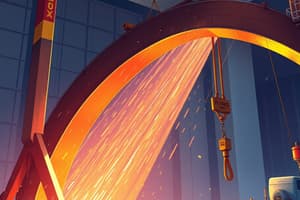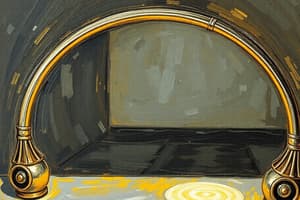Podcast
Questions and Answers
What is the maximum allowed wrinkle or kink in tubes for fluid systems with working pressures of 500 psi or greater?
What is the maximum allowed wrinkle or kink in tubes for fluid systems with working pressures of 500 psi or greater?
- 1% of the tube OD (correct)
- 0.5% of the tube OD
- 5% of the tube OD
- 2% of the tube OD
Why is it essential to determine the cause of a tube failure?
Why is it essential to determine the cause of a tube failure?
- To report the incident to the authorities
- To identify the manufacturer's defect
- To replace the tubing with a new one
- To prevent similar failures from occurring in the future (correct)
What is the purpose of pressure-testing tubing prior to installation?
What is the purpose of pressure-testing tubing prior to installation?
- To ensure the tubing can withstand several times the normal operating pressure (correct)
- To test the tubing's flexibility
- To ensure the tubing can withstand normal operating pressure
- To test the tubing's durability
What should be used at points where the tubing passes through bulkheads?
What should be used at points where the tubing passes through bulkheads?
What is the minimum clearance required between tubing and structure or rigid members, unless otherwise specified?
What is the minimum clearance required between tubing and structure or rigid members, unless otherwise specified?
What is the primary reason for replacing damaged aircraft fluid lines?
What is the primary reason for replacing damaged aircraft fluid lines?
Why may replacement tubing need to be fabricated?
Why may replacement tubing need to be fabricated?
What is the maximum allowable distance between supports for tubing, according to the table?
What is the maximum allowable distance between supports for tubing, according to the table?
What is the purpose of using the Bend Allowance Chart?
What is the purpose of using the Bend Allowance Chart?
What is the formula for calculating bend allowance?
What is the formula for calculating bend allowance?
How do you calculate the flat dimension?
How do you calculate the flat dimension?
What is the purpose of dividing the bent object into flats and bend allowances?
What is the purpose of dividing the bent object into flats and bend allowances?
What is the minimum bend radius for tube bending?
What is the minimum bend radius for tube bending?
What is the acceptable method for bending soft, non-heat-treated aluminium tubing in an emergency?
What is the acceptable method for bending soft, non-heat-treated aluminium tubing in an emergency?
What is the objective of tube bending?
What is the objective of tube bending?
What is the purpose of the stick diagram of tubing development?
What is the purpose of the stick diagram of tubing development?
What is the primary concern when cutting tubing?
What is the primary concern when cutting tubing?
What tool is used to remove both inside and outside burrs from tubing?
What tool is used to remove both inside and outside burrs from tubing?
What is the consequence of slight damage to the tubing wall during deburring?
What is the consequence of slight damage to the tubing wall during deburring?
Why should the cut end of the tube be polished before flaring?
Why should the cut end of the tube be polished before flaring?
What are the two major types of tube joints?
What are the two major types of tube joints?
What is the purpose of the tube flaring tool?
What is the purpose of the tube flaring tool?
What can happen to the tube if it is not properly cleaned and deburred?
What can happen to the tube if it is not properly cleaned and deburred?
What should be checked on the tube ends before flaring?
What should be checked on the tube ends before flaring?
What is the purpose of the swivel nut or flange?
What is the purpose of the swivel nut or flange?
What is unique to each manufacturer's hose fittings?
What is unique to each manufacturer's hose fittings?
Why should nipples and sockets from different manufacturers not be intermixed?
Why should nipples and sockets from different manufacturers not be intermixed?
What is the purpose of colour-coding on hose fittings and nuts?
What is the purpose of colour-coding on hose fittings and nuts?
What is the recommended pressure for testing fabricated hoses?
What is the recommended pressure for testing fabricated hoses?
What is the alternative to pressure testing a new purchased hose from an approved vendor?
What is the alternative to pressure testing a new purchased hose from an approved vendor?
What is the consequence of a hose assembly failing the pressure test?
What is the consequence of a hose assembly failing the pressure test?
What is the importance of following safety procedures during pressure testing?
What is the importance of following safety procedures during pressure testing?
When installing hose or hose assemblies, what should be ensured regarding identification markings?
When installing hose or hose assemblies, what should be ensured regarding identification markings?
What can happen to the length of the hose when pressure is applied?
What can happen to the length of the hose when pressure is applied?
Why should swivel connector nuts be finger-tightened initially?
Why should swivel connector nuts be finger-tightened initially?
How should the final torque be applied to end fittings?
How should the final torque be applied to end fittings?
Why should the hose be held manually when applying final torque?
Why should the hose be held manually when applying final torque?
What should be used to prevent chafing when routing and clamping the flexible hose?
What should be used to prevent chafing when routing and clamping the flexible hose?
What should be ensured when supporting the flexible hose or hose assemblies?
What should be ensured when supporting the flexible hose or hose assemblies?
When flexing is required in an installation, how should the hose be bent?
When flexing is required in an installation, how should the hose be bent?
Flashcards are hidden until you start studying
Study Notes
Calculating Bend Allowances
- Use the Bend Allowance Chart or formula to calculate bend allowances
- Formula: angle of bend / (2πR) × 360°
Calculating Flats
- Calculate flats by subtracting setback for each bend from overall dimension
- This leaves the flat dimension
Calculating Overall Length
- Divide bent object into flats and bend allowances
- Number them progressively (e.g., 1-2, 2-3, 3-4, etc.)
- Calculate each length independently, then lay out calculations
- Development length equals the total of all lengths
Tube Bending
- Objective: obtain smooth bend without flattening tube
- Use mechanical or hand-operated tube bender
- Minimum bend radius: 2.5 to 3 times the OD
Tube Cutting
- Produce square end, free of burrs
- Remove burrs from inside and outside the tube using a de-burring tool
- Avoid reducing or fracturing the wall thickness of the tubing
Tube Flaring
- Preparation: use tube flaring tool to prepare tube ends
- Check tube ends for roundness, square cut, and cleanliness
- Remove draw marks and scratches
Tube Joint Preparation
- Two major tube joints: flared fitting and flareless fitting
- Flared fitting: single-flared joint and double-flared joint
Wrinkle or Kink Limitations
- Wrinkles or kinks in tubes: limit to 1% of tube OD for working pressures ≥ 500 psi
- Limit to 2% of tube OD for working pressures < 500 psi
Typical Repairs
- Repair or replace damaged aircraft fluid lines
- Use replacement tubing of the same size and material as original
- Pressure-test tubing prior to initial installation
Clamps
- Maintain minimum clearance of 1/16 in. or 1/4 in. between supports
- Use flexible grommets or hose at points where tubing passes through bulkheads
Pressure Test Stands
- Hydraulic or pneumatic pressure test fabricated hoses prior to installation
- Test to 1.5 times system pressure
- New purchased hoses can be operationally checked after installation
Installation Procedures
- Remove protective closures from hydraulic lines, hose, or hose assemblies
- Install hose or hose assemblies without twisting, chafing, or over bending
- Observe bend radius and allow for component movement and possible changes in length
Studying That Suits You
Use AI to generate personalized quizzes and flashcards to suit your learning preferences.




